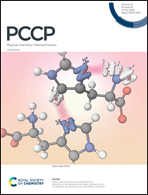Understanding the bulk and interfacial structures of ternary and binary deep eutectic solvents with a constant potential method: a molecular dynamics study†
Abstract
In the last decade, deep eutectic solvents (DESs) have emerged as promising electrolytes in supercapacitors and rechargeable batteries due to their unique properties, wide electrochemical windows, low viscosity, and high ionic conductivity. The molecular structural behavior of these solvents, which plays an important role in their efficiency is not deeply understood. Therefore, in this work, by considering two types of DES electrolytes, we investigate their bulk and interfacial structures at the molecular level using molecular dynamics studies. In this regard, two different DESs—a binary DES including choline chloride and urea in a 1 : 2 molar ratio, and a ternary DES containing choline chloride, urea, and ethylene glycol with a molar ratio of 1 : 1 : 2—are considered. For the bulk phase, the partial site–site and center of mass radial distribution functions (RDFs), the mean square displacement (MSD), and the self-diffusion coefficient of the ternary system are explored. We demonstrate that in deep eutectic solvents, in addition to hydrogen-bonding and long-range and short-range correlations, a variety of neutral species play crucial roles in the properties of the bulk phase. Furthermore, considering two graphene sheets as electrodes on both sides of the DES samples, the profiles of the number density, charge density, orientational order parameter, and electrostatic potentials at different potential conditions near the electrodes are investigated. The results reveal the presence of multilayers of the neutral species in the vicinity of electrodes in addition to the ionic components of both DES systems. Finally, the computed differential capacitances (Cd) for DESs disclose that the positive electrode capacitance is higher than that of the negative electrode, and in the ternary system, the total capacitance is greater than in the binary system. Our findings give a better perspective of a new generation of electrolytes at the molecular level for electric double-layer capacitors.



 Please wait while we load your content...
Please wait while we load your content...